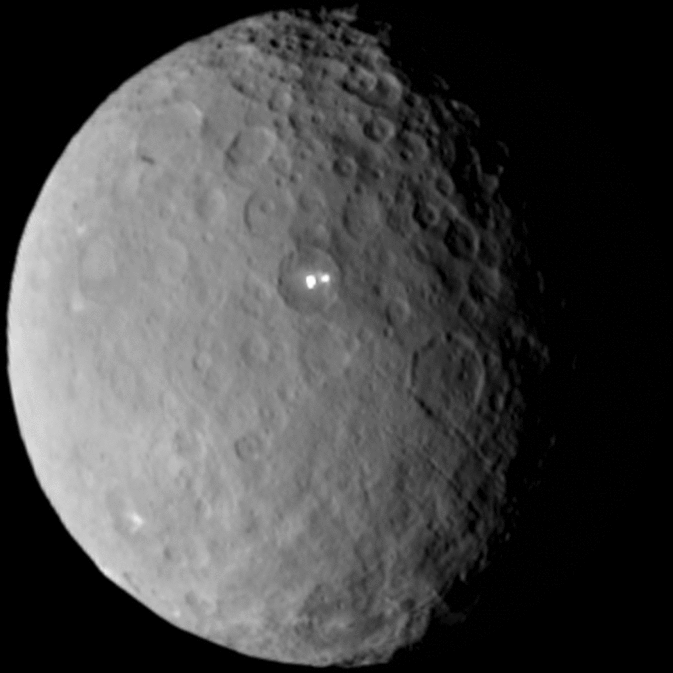(an update on the Unexplainable Lights on Ceres)
In 2015
Images sent back from NASA’s Dawn space probe revealed two bright spots on the surface of the dwarf planet Ceres. These lights were unexpected and a mystery said investigators of the mission at the time.
Ceres’ a rotation takes about nine hours. Above is a hyped-up video made up of images sent from Dawn as the spacecraft approached the dwarf planet. Wait for the mysterious lights. Wait for it. And there they are.
At First
When first observed, investigators believed the light spot to be singular. However, as Dawn drew closer to the planet, newer images revealed that the one bright spot had a companion.
On the NASA website, Chris Russell, principal investigator for the Dawn mission, based at the University of California in Los Angeles stated:
Ceres’ bright spot can now be seen to have a companion of lesser brightness, but apparently in the same basin. This may be pointing to a volcano-like origin of the spots, but we will have to wait for better resolution before we can make such geologic interpretations.”
The images were captured from a distance of 29,000 miles (46,000 kilometers) and sent back to NASA on February 19, 2015.
On February 25, 2015, Andreas Nathues, lead investigator for the framing camera team said,“The brightest spot continues to be too small to resolve with our camera, but despite its size it is brighter than anything else on Ceres. This is truly unexpected and still a mystery to us.”
The framing camera team is located at the Max Planck Institute for Solar System Research in Gottingen, Germany.
Dawn entered orbit around Ceres on March 6, 2015, and scientists believed that as they received better and clearer views of the planet over the next 16 months, the true nature of the lights would be revealed.
ProbeFiling
Ceres was first spotted in 1801 by Sicilian astronomer Father Giuseppe Piazzi. At first it was classified as a planet, then moved to asteroid, and then—because of its planet-like nature—labeled a dwarf planet, along with Pluto and Eris, in 2006
(ProbeNote: The planet was named after the Roman goddess of agriculture and harvest. Names for craters on Ceres will be taken from other world myths of the gods and goddesses of agriculture and vegetation. Other features discovered on Ceres will be named after agricultural festivals.)
Dawn’s mission was to identify the characteristics of our early solar system and the processes that dominated its formation. She is the first space probe to orbit two extraterrestrial bodies, the first to visit Ceres and Vesta, and the first to study a dwarf planet.
Thus far in Dawn’s decade-long mission, she has explored Vesta, a giant asteroid, for 14 months in 2011 and 2012. Dawn uses an ion propulsion system as opposed to chemical propulsion. Her three ion engines make her more efficient.
Her story is never-ending as she remains in orbit — a perpetual satellite around Ceres— even at the end of her mission.
More on Ceres and Vesta
Vesta and Ceres both orbit the sun between Mars and Jupiter, in the main asteroid belt. Each features significant differences. It is because of these differences that Ceres and Vesta were chosen for Dawn’s mission.
- is the most massive object in the asteroid belt
- its surface covers about 38% of the area of the continental US
- has a primitive surface containing water-bearing minerals
- is 25% water by mass
- may possess a weak atmosphere
- appears to have similarities to those of the large icy moons of the outer solar system
- has an average diameter is 326 miles (525 kilometers)
- is the second most massive body in the belt
- was formed earlier than Ceres
- is a very dry body unlike Ceres
- surface shows signs of resurfacing
- resembles the rocky bodies of the inner solar system, including Earth
“Both Vesta and Ceres were on their way to becoming planets, but their development was interrupted by the gravity of Jupiter,” said Carol Raymond, deputy principal investigator at NASA’s Jet Propulsion Lab (JPL). “These two bodies are like fossils from the dawn of the solar system, and they shed light on its origins.”
What has Been Determined Since 2015
Below is a recent YouTube video explaining the images sent back by Dawn of the dwarf planet Ceres.
How about you, do you believe the lights are what the video suggests or something more? And if we were to find out that they are alien, should we try to make contact?
The Probe’s Mission Statement
- Coghlan’s Traveling Coffin Urban Legend - April 4, 2024
- Richmond Vampire Urban Legend - March 7, 2024
- Lick Lick Urban Legend - February 8, 2024



